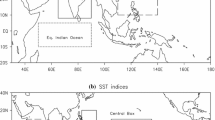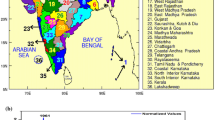Abstract
Indian summer monsoon rainfall (ISMR) variability of ± 10% of its long-term mean leads to flood and drought, affecting the life and economic situation of the country. It is already established that the interannual variability of ISMR is influenced by large-scale boundary forcing such as SST anomalies of tropical Pacific, Indian, and Atlantic Oceans. The ISMR association between Pacific SST anomalies in the form of El Niño Southern Oscillation (ENSO) is only studied in detail. Meanwhile, the present and previous studies show that the ENSO accounts for around 50% of the extreme years, while the other half is associated with other processes such as Atlantic Nino. A differentiation between extremes induced by ENSO and non-ENSO processes is attempted here with the help of moisture and moist static energy budget. The significant contribution to the rainfall extremes comes from moisture advection induced by anomalous winds generated by the boundary forcing and the second contribution from moisture convergence. For the non-ENSO cases, there is a contribution from local fluxes, which are not prominent in the cases of ENSO induced cases. In the ENSO cases, anomalous winds are from the equatorial central Pacific, while EQWIN/IOD cases influence extremes through the local evaporation and moisture advection from the Indian Ocean. Extreme years independent of ENSO/IOD/EQWIN have moisture advection from the anomalous winds across Africa and the Atlantic and are associated with moisture advection toward the northern parts of India. These differences in moisture processes can be responsible for the difference in rainfall distribution over India.







Similar content being viewed by others
Data availability
All the data sets used are available online from NCEP (atmospheric variables) https://psl.noaa.gov/data/gridded/data.ncep.reanalysis.html, HadISST from https://www.metoffice.gov.uk/hadobs/hadisst/data/download.html, and IMD rainfall from https://www.imdpune.gov.in/Clim_Pred_LRF_New/Grided_Data_Download.html. Processed data can be made available on request.
Code availability
Moisture and moist static energy budget calculation code can be made available on request.
References
Abrol YP, Gadgil S (1999) Rice-in a variable climate. APC Publications Pvt Ltd, New Delhi, p 243
Ajayamohan RS, Rao SA (2008) Indian Ocean dipole modulates the number of extreme rainfall events over India in a warming environment. Journal of the Meteorological Society of Japan Ser II 86:245–252. https://doi.org/10.2151/jmsj.86.245
Annamalai H, Ping L, Shang-Ping X (2005) Southwest Indian Ocean SST variability: its local effect and remote influence on asian monsoon. J Clim. https://doi.org/10.1175/JCLI3533,pp.4150-4167
Charney JG, Shukla J (1981) Predictability of monsoons. In: Lighthill J, Pearce RP (eds) Monsoon dynamics. Cambridge University Press, pp 99–108
Chung C, Nigam S (1999) Asian summer monsoon—ENSO feedback on the Cane-Zebiak model ENSO. J Climate 12:2787–2807
Gadgil S, Rupakumar K (2006) The Asian monsoon-agriculture and economy. In: Wang B (ed) The asian monsoon, chapter 18. Springer, Berlin, Heidelberg, pp 651–683
Gadgil S, Vinayachandran PN, Francis PA, Gadgil S (2004) Extremes of the Indian summer monsoon rainfall, ENSO and equatorial Indian Ocean oscillation. Geophys Res Lett 31:L12213. https://doi.org/10.1029/2004GL019733
Gadgil S (1996) Climate change and agriculture—an Indian perspective. In: Abrol YP, Gadgil S, Pant GB (eds) Climate variability and agriculture. Narosa, New Delhi, pp 1–18
Kalney E et al (1994) The NCEP/NCAR 40-Year Reanalysis Project. BAMS 77:437–472
Krishna Kumar K, Rupa Kumar K, Ashrit RG, Deshpande NR, Hansen JW (2004) Climate impacts on Indian agriculture. Int J Climatol 24:1375–1393. https://doi.org/10.1002/joc.1081
Pai DS, Latha Sridhar, Rajeevan M, Sreejith OP, Satbhai NS, Mukhopadhyay B (2014) Development of a new high spatial resolution (0.25° X 0.25°)long period (1901–2010) daily gridded rainfall data set over India and its comparison with existing data sets over the region. MAUSAM 65(1):1–18
Pillai P, Annamalai M (2012) Moist dynamics of severe monsoons over South Asia: role of the tropical SST. J Atmos Sci 69:97–115
Rajeevan M, Sridhar L (2008) Inter-annual relationship between Atlantic sea surface temperature anomalies and Indian summer monsoon. Geophysical Research Letters 35:L21704. https://doi.org/10.1029/2008GL036025
Rajeevan M, Jyoti B, Jaswal AK (2008) Analysis of variability and trends of extreme rainfall events over India using 104 years of gridded daily rainfall data. Geophys Res Lett 35:L18707. https://doi.org/10.1029/2008GL035143
Rasmussen EM, Carpenter TH (1983) The relationship between eastern equatorial Pacific sea surface temperature and rainfall over India and Sri Lanka. Mon Wea Rev 111:517–528
Rayner NA, Parker DE, Horton EB, Folland CK, Alexander LV, Rowell DP, Kent EC, Kaplan A (2003) Global analyses of sea surface temperature, sea ice, and night marine air temperature since the late nineteenth century. J Geophys Res 108(D14):4407. https://doi.org/10.1029/2002JD002670
Saji NH, Goswami BN, Vinayachandran P, Yamagata T (1999) A dipole mode in the tropical Indian Ocean. Nature 401:360–363
Su H, Neelin DJ (2002) Teleconnection mechanisms for tropical pacific descent anomalies during El Niño. J Atmos Sci 59:2694–2712
Swaminathan MS (1987) Abnormal monsoons and economic consequences: The Indian experiment. In Fein JS Stephens PL (eds) Monsoons. Wiley and Sons, New York, pp121–134
Trenberth KE (1997) The Definition of El Niño BAMS 78(12):2771–2777. https://doi.org/10.1175/1520-0477(1997)078%3c2771:TDOENO%3e2.0.CO;2
Walker GT (1924) Correlation in seasonal variations of weather. IV : a further study of world weather. Mem Indian Meteorol Dept 24:275–332
Webster PJ, Moore AM, Loschnigg JP, Leben RR (1999) Coupled ocean–atmosphere dynamics in the Indian Ocean during 1997–98. Nature 401:v356-360
Webster PJ, Magana VO, Palmer TN, Shuka J, Tomas RT, Yanai M, Yasunari T (1998) Monsoons: processes, predictability and the prospects of prediction. J Geophys Res 103(C7, 14):451–510
Webster PJ, Yang S (1992) Monsoon and ENSO: selectively interactive systems. Quart J Roy Meteor Soc 118:877–926
Yadav RK (2009) Role of equatorial central Pacific and northwest of North Atlantic 2-metre surface temperatures in modulating Indian summer monsoon variability. Cli Dyn 32(4):549–563. https://doi.org/10.1007/s00382-008-0410-x
Yadav RK (2009) Changes in the large-scale features associated with the Indian summer monsoon in the recent decades. Int J Climatol 29(1):117–133. https://doi.org/10.1002/joc.1698
Yadav RK (2017) On the relationship between east equatorial Atlantic SST and ISM through Eurasian wave. Cli Dyn 48:281–295
Yadav RK, Srinivas G, Chowdary JS (2018) Atlantic Niño modulation of the Indian summer monsoon through Asian jet. (Nature Partner Journals) NPJ Climate and Atmospheric Science 1:23. https://doi.org/10.1038/s41612-018-0029-5
Yadav RK, Wang Simon S-Y, Chi-Hua Wu, Gillies RR (2020) Swapping of the Pacific and Atlantic Niño influences on north central India summer monsoon. Clim Dyn 54(9):4005–4020. https://doi.org/10.1007/s00382-020-05215-4
Acknowledgements
Authors are thankful to Prof. Ravi S. Nanjundiah, Director, Indian Institute of Tropical Meteorology (IITM) and Dr. Suryachandra A Rao, Program manager, Monsoon Mission, IITM, for encouraging to carry out this research work. The IITM HPC support is duly acknowledged. A. R Dhakate also acknowledges Savitribhai Pule University Pune. The IITM is fully funded by the Ministry of Earth Sciences, Government of India. The authors have no conflicts of interest to declare. All the figures are prepared using Ferret software freely available from https://ferret.pmel.noaa.gov/Ferret/
Author information
Authors and Affiliations
Contributions
A. R Dhakate: formal analysis, conceptualization, validation, software, and writing original draft. P.A Pillai: conceptualization, supervision, methodology, validation, writing, reviewing, and editing.
Corresponding author
Ethics declarations
Ethics approval
Not applicable.
Consent to participate
Not applicable.
Consent for publication
Not applicable.
Conflict of interest
The authors declare no competing interests.
Additional information
Publisher's note
Springer Nature remains neutral with regard to jurisdictional claims in published maps and institutional affiliations.
Rights and permissions
About this article
Cite this article
Dhakate, A.R., Pillai, P.A. Seasonal extreme rainfall over Indian monsoon region: a moisture budget analysis to distinguish the role of ENSO and non-ENSO forcing. Theor Appl Climatol 148, 1603–1613 (2022). https://doi.org/10.1007/s00704-022-04016-5
Received:
Accepted:
Published:
Issue Date:
DOI: https://doi.org/10.1007/s00704-022-04016-5




